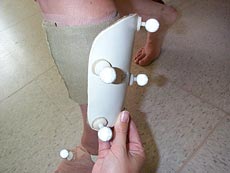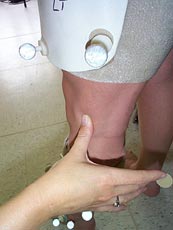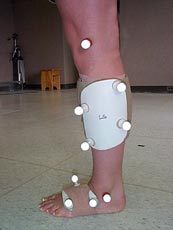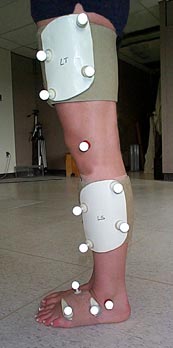|
Note: The following is provided as a general overview
of the technique but is not intended as specific instructions for its application.
General Principles:
At the NIH, a 6-Degree of Freedom approach to
motion capture is used. The motion of each body segment is tracked independently.
Calibration Targets are reflective markers placed on
the surface of the subject's skin over specific skeletal landmarks. Tracking
Targets are "clusters" of markers mounted to lightweight rigid "shells"
and attached to each limb segment.
Each shell provides a relatively rigid surface for positioning
targets. Ideally, the Neoprene wraps do not affect limb movement, yet
decrease the amount of movement between the shell and the underlying skeleton.
A minimum of 3 non-colinear targets per shell are required
for data collection; however, 4 are traditionally used. This provides
redundancy and helps compensate in the event a target is momentarily obscured.
The subject is instructed to stand still in an anatomically
neutral position and motion capture data is collected for 1 to 2 seconds.
Analysis software uses the Calibration Targets to determine the orientation
of the Tracking Targets relative to the underlying skeleton.
Prior to data collection of the motion of interest,
the Calibration Targets are removed leaving only the Tracking Targets
in place.
Example Target Application (lower body,
only left side shown):
A rigid shell made from heat-shapeable plastic is placed
on the top of the subject's foot with the anterior-most target positioned
near the head of the 5th metatarsal (figure 1). Velcro patches on the
shell provide mounting points for the Tracking Targets. Elastic tape is
snugly wrapped around the foot and across the shell to hold it in place
(figures 2, 3). Reflective spheres on Velcro pedestals are then placed
on the Velcro patches of the shell. An adhesive Velcro patch is placed
on the subject's lateral malleolus and another reflective sphere, on a
shorter pedestal, is attached (figure 4). This last target serves as a
Calibration Target. Similarly, in a rather unique situation, the target
located on the shell over the 5th metatarsal head is frequently assigned
a dual role as both a Tracking Target and a Calibration Target.
|

















